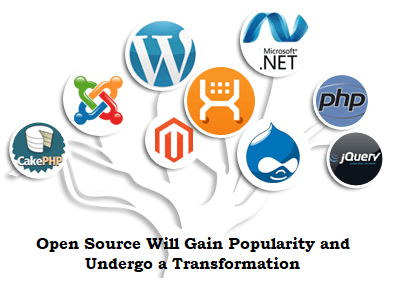Open Source Will Gain Popularity and Undergo a Transformation

When the best minds come together to develop a project, the outputs are usually amazing. Incorporating open source in the code is an essential way to keep up with the latest technology and also be a part of the larger community. Open source as an industry has gained momentum and users are free to implement the technology as per the needs. The focus of open source technology is to reduce the costs and enhance the organization’s performance through higher efficiency. Today, from financial giants to service providers are creating their businesses around the community based technology that has brought great changes in the IT world.
Open source software development has opened up new vistas for organizations to satisfy their dynamic requirements through cutting edge technologies that include Joomla, Drupal, Magento, PHP, WordPress and etc. These days more than 95% of all the applications are developed on open source platform so as to enable developers to reduce cost, accelerate time to market, increase flexibility and also obtain several other benefits. With technology always in a continuous state of development, old paradigms and established ways are giving ways to new things.
Critical gaps will be redressed:
The open source coding and community has of course come a long way and is at present the most preferred way to develop applications and also enhance the code. With latest trends, collaboration will become more seamless and the collaborative platform will get enhanced functionalities that will include polling capability, video conferencing and etc. where developers can form groups and work.
Another critical gap related to open source development is related to support and troubleshooting. Since it depends more on community users to solve glitches, it is never considered to be a very reliable model. But to fulfil this, there is efforts to provide commercial services to support open source software.
Security to become center stage
Open source software has always been very prone to cyber-attacks because of its open and free nature that allows anyone to modify the code thereby increasing the chances of vulnerabilities. The attacks are usually high impact ones and target lucrative applications. Developers and security experts are now focusing more to strengthen the defenses, especially encryption. Enterprises are also adopting cloud and mobile application so that employees can also access outside the company firewall.
Server less computing:
This is also known as Function as a Service, and is one important technology gaining importance and is also likely to gain popularity in the coming years. FaaS allows the developers to use virtual machines based on the user demands rather than purchase allotted space and the bill is also based on resource consumed rather than on a per hour basis. Microsoft Azure, Google Cloud and AWS Lambda have already started to offer server less computing platform.
IoT and related applications:
Open source is often the most preferred platform for various IoT applications and such technology is used in automobiles where they are fully controlled automatically and even remotely. The pace of adoption of open source technologies in IoT will increase exponentially in the year 2017.
Open source database systems:
Open source has become the standard infrastructure software and popular database management systems like MySQL, MongoDB, PostgreSQL, which were overshadowed will make a comeback for new capabilities and features. Existing open source technologies like Drupal 8 will even mature further and offer great flexibility to the developers.
To conclude, we can say that open source is sure to become the most preferred choice of all the developers that will enhance business efficiency and open up avenues for increased revenues.
Important Elements to Consider While Designing a Multilingual Website

Consumers who purchase online usually prefer to buy from sites if they are in their native language. A survey stated that people only shopped from websites that they were comfortable with and helped them to make buying decisions easy. So, translating your site in various languages will help you to capture the market, but it can be a big undertaking. While software development companies strive to make the actual translation a smooth and carefree process, there is much to consider upon before the work starts.
Here in this blog, I will discuss in details about the important elements that should be focused on while designing a multilingual website. Let us discuss how you can create an exceptional and attractive global UX that will help you to provide your customers a consistent look and feel across all your global sites.
Designing of the website is very important if you want to stand out from the crowd.
Select global templates for consistent branding:
You can direct your audience to access your website, but you cannot control which site your international visitors will access. Some German visitors may be visiting your U.K site or your French site. You already are aware that you should maintain a consistent brand image and each site should be a representation of your master website. It is suggested that the sites are customizable to meet the tastes of the local audiences and to do this, you should select a global template for your multilingual site. Your designs and layout templates should be optimized for mobile and desktops as it helps to increase the efficiencies, maintain control over visual presentations, manage text expansions and also increase branding elements. Such templates enable the teams to run regional campaigns and meet specific local preferences and expenses.
Develop websites to use a range of global internet speeds:
Before the visitors can do anything, the website must first load. If you keep your users waiting until all the text or images have loaded, then it is likely that your visitors will leave for some other site. Internet speed varies greatly all around the world and it is important to create the design of the website so that it can match the internet speed. So, remove, modify, or optimize your graphical images or large files that could slow down the time for international users.
Create global gateways and keep users in mind:
While creating global templates, it is important to pay special attention while designing the global gateways. The gateways are the navigational system that helps to direct the users to localized versions of the website. The design and placement of the gateway are also important and the process of finding it should be effortless. There are few designs that are used for it, and the most common is the drop down box where the users can select a particular language from the scrolling list.
Ensure international shopping and shipping experiences:
When it is all about multilingual ecommerce websites, there are various steps that you should follow while designing. Once you have a clear idea about the local laws, purchases and shipping, you have to work on multilingual website development to adjust for different currencies and shipping formats. The functionalities should be addressed in the designing process so that you can internationalize the site to accommodate the variables.
Support global variations of time and date format:
Be aware of local formats when it comes to dates and time. English speaking countries often use a 12-hour clock, but European countries use the 24-hour clock. Even calendar date formats may also vary and should be used according to the local preferences.
Images, icons should be culturally and contextually appropriate:
Your commercial graphics, icons, symbols and photographs should be attractive without being offensive in any cultures. For this, you should do some research and avoid using images of animals or any religious symbols. Choose to use culturally appropriate people in images and play it safe.
Use the best practices for designing multilingual websites, so that it offers the best experience to the users through consistent look and performance of the website.
Blog Reference: http://ezinearticles.com/?Important-Elements-to-Consider-While-Designing-a-Multilingual-Website&id=9826941
Understanding The Liquid Content in DNN
If you have planned to consider DotNetNuke for building your website, then it is vital to understand the advantages of the platform and how the great CMS makes content management task easier. Whether you have a team of writers or editors, DNN offers its users rich text editors and various other options to create great content. DNN has announced the availability of Evoq 9 that offers omnichannel publishing through a micro service architecture. Evoq 9 includes Liquid Content, which is a new content as a Service platform.

The Liquid content:
We all know the fact that liquid takes the shape of any object it is placed in and also flows around the obstacles or barriers. So with such type of content, it becomes convenient for context editing, can be re-used or even published to channels that are beyond your site. The liquid content allows you to manage, store and organize all your content via cloud based micro service. It serves as a headless CMS for creating, organizing and managing the content and it is from your Liquid Content that you can publish to your Evoq website or even use a stateless API and publish materials to a Kiosk, microsite, app or even another CMS.
Visualizers:
Prior to Evoq 9, content was mostly associated with a page. Though this was convenient for in-context editing, this was a great challenge during re-use of content, or when it had to be published to varied channels. The key element of Liquid Content, are Visualizers that help to bring content on a page with a look and feel that can be selected and customized easily. The library offers about 100+ visualizers for publishing press releases, webinars, articles, news and many more.
Dynamic Lists:
Content types are actually the building blocks of Liquid Content and visualizers support dynamic lists that are updated when new content items are created. For example, when a marketer publishes a new webinar, the visualizer automatically updates and includes the latest webinar.
Microservices via API:
The Microservice allows the users to specifically focus more on the value of delivering their services and content instead of upgrading to a new version in a monolithic CMS. In the CaaS delivery model, the content is independently created from the place where it will be used and the presentation layers is then separated from the backend that handles the storage of the content and its delivery.
The Benefits of Liquid Content
IT managers: Now IT managers can easily configure the permissions and settings in the Liquid Content, which will enable the business owners to manage content without any hurdles that might break the site. Since Liquid Content is designed for specific users, IT managers don’t have to spend time training the users and won’t even need specialized IT staff to write codes needed with other offerings.
Developers: They are provided with a documented REST API for creating the front end experience using Liquid Content. There are more than 100+ visualizers that can easily be customized with JavaScript and CSS.
Marketers: They face the problem that most of the software is affordable only for large enterprises and they need to take the help of developers or even work with an implementation partner. But Liquid Content has made it more affordable and at the same time empowers the business users to leverage omnichannel publishing that needs no programming. It offers a drag and drop user interface that needs the help of a developer in other competitive products.
Mobile App Development and Its Implications On the Retail Industry
Mobile technology has evolved as a prime engine of economic growth, stimulating various retail sectors to spend on their infrastructure and research and development and also affecting the daily lives of people. Today, mobile apps have opened up new vistas of opportunities for small as well as big businesses. From documenting expenses to customer relationship management to facilitating payments, mobile apps are now playing an increasingly significant role in generating business growth.

The much hyped mobile revolution has impacted businesses more through mobile apps than any other avenues. These apps are continuously changing the way customers interact with the brands and help in more customer engagement and collaboration in workplaces. For retailers who are persuading consumers to use their mobile apps are at present able to capture a wider market base. Not only such users tend to visit the retail store, more frequently, but they are also typically more loyal. Since people are now more addicted towards using Smartphones and prefer to manage all the internet activities through them, the mobile app development has helped them to remain connected to the technology world and continue with shopping at the comfort of home.
A look at how the mobile app development is beneficial to the retail industry:
Helps to establish trust among users:
Creating a mobile app for your potential mobile customers helps to increase the sales by creating any loyalty campaign. This may include various offers, discount coupons and other marketing campaigns that help the retailers to cross-sell opportunities and also to increase engagement. Retailers also use the apps to boost their sales and marketing strategies based on the latest market trends and the data that is gathered by the loyalty campaigns like sales coupons, special discounts and etc.
Reach out to customers far and wide:
For startup, becoming a global band is no more a difficult job. There are practically many business organizations that count, but only a small portion of the small businesses took advantage of the mobile revolution by offering handy apps to their customers for a wonderful experience with transactions and shopping. From offering local products to a global audience to better value for investment, mobile apps can play a crucial role in reaching out to the customers across locations and countries. Building brand presence in faraway places has become easy and with geo location technologies, engaging customers with localized content has become easier. It is by creating a mobile app presence, that you can constantly keep in touch with the users on the go. The app helps to make your store readily available to all your audience any time of the day.
Boosting traffic and brand awareness:
The brand image creates a long-lasting impression before the customer’s eyes and visibility plays a great role in it. A popular app can help to gain higher business visibility compared to other digital avenues, because it continuously remains in your pocket and is displayed on the mobile screen. Not only this, the mobile app development company can also help to boost your website traffic and help to create a lasing and good impression. When it comes to digital marketing, mobile presence is invincible.
Best shopping experience:
When customers choose to shop online, the basic thing that they need is to see all the information about the product and its images from various angles. With advanced business apps, retailers are now able to display all the information that is related to the specific product with the images and specifications. In this way, they are now able to add more value to their potential customers and offer them a flawless and awesome buying experience.
Gathering insights on consumers and offering better collaboration:
With the widespread adoption of Bring Your Own Device (BYOD) policies, real time collaboration among partners, employees and customers has become easier. Today’s mobile devices have various device specific sensors that make it easy to collect accurate user behavior data based on their location, demographics, buying habits, preferences and etc. This helps to modify the marketing campaigns accordingly. Real time user feedback, great workplace collaboration and diverse insights help to make the science of marketing more objectively driven. Mobile app development now represents the most popular digital space and also offers huge opportunities for various businesses to tap newer markets and potential customers.
Creating newer marketing strategies:
Targeting global market has become quite easy by building mobile apps that target specific industries. Integrating the apps with social channels helps to add more flexibility and do the marketing of the products efficiently. Retailers are also now adopting mobile technology so that they can expand their business worldwide and make their services or products available in a detailed manner.
Remain unique in the market:
Retail players always build specific mobile apps to boost their business. So, remaining at pace with the latest technology developments brings a positive change. It not only helps to build brand awareness, but also keeps you competitive and presents you as adopting the latest trends of the market. Having an attractive mobile app helps to add benefits and boosts customer engagements.
“This is why many retailers are now turning to develop mobile apps for their business and focusing more to offer a convenient shopping experience to their potential customers.”

